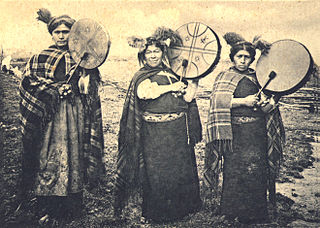Gualichu, or gualicho, in Mapuche mythology and mainly in the Tehuelche culture, was an evil spirit or demon, comparable but not similar to the Devil.

The Mapuche is a group of native indigenous inhabitants of south-central Chile and southwestern Argentina, including parts of Patagonia. The collective term refers to a wide-ranging ethnicity composed of various groups who share a common social, religious, and economic structure, as well as a common linguistic heritage as Mapudungun speakers. Their homelands once extended from Choapa Valley to the Chiloé Archipelago and later spread eastward to Puelmapu, a land comprising part of the Argentine pampa and Patagonia. Today the collective group makes up over 80% of the indigenous peoples in Chile and about 9% of the total Chilean population. The Mapuche are concentrated in the Araucanía region. Many have migrated from rural areas to the cities of Santiago and Buenos Aires for economic opportunities.
The Nguruvilu is a creature originating from the Mapuche religion of the indigenous people inhabiting Chile. It is a river-dwelling creature that looks like a fox, with a long body, similar to a snake, and a long tail with fingernails that it uses like a claw.
Kalku or Calcu, in Mapuche mythology, is a sorcerer or witch who works with black magic and negative powers or forces. The essentially benevolent shamans are more often referred to as machi, to avoid confusion with the malevolent kalku. Its origins are in Mapuche tradition.

A machi is a traditional healer and religious leader in the Mapuche culture of Chile and Argentina. Machis play significant roles in Mapuche religion. In contemporary Mapuche culture, women are more commonly machis than men, but it is not a rule. Male machi are known as Machi Weye.

The religion of the indigenous Mapuche people of south-central Chile and southwestern Argentina is an extensive and ancient belief system. Legends and myths are common to the various groups that make up the Mapuche people. These myths tell of the creation of the world and the various deities and spirits that reside in it.

The Chonchon, also known as the Tue-Tué, is a mythical creature found in Mapuche religion, as well as in the folk mythologies of Chile and southern Argentina.
The legend of Trentren Vilu and Caicai Vilu (Kaikai) is a Mapuche flood myth that tells the story of a fierce battle between two mythical snakes, Trentren Vilu and Caicai Vilu. It explains how the Chilóe archipelago and mountains of southern Chile came to have its unique geography.
Ten Ten-Vilu or Trentren-Vilu is the Mapuche god of earth and fertility ; he has a generous spirit and is the protector of all life on Earth, and the flora and fauna and according to some Mapuche myths. This snake was a central figure in the origin of the Chiloean Archipelago. In Mapuche mythology, Ten Ten-Vilu is son of Antü.

Coi Coi-Vilu or Caicai-Vilu/Cai Cai Vilu is the Mapuche god of water and, according to Mapuche myths, supreme ruler of the sea and of all sea-dwellers. This snake was a central figure in the origin of the Chiloean Archipelago. In Mapuche mythology, Coi Coi-Vilu is son of Peripillan.
The Pillan are powerful and respected male spirits in Mapuche mythology.
In Mapuche mythology, Ngen or " Ngen-ko " are spirits of nature of the Mapuche beliefs. In Mapudungun, the word ngen means "owner".
Mythic humanoids are legendary, folkloric, or mythological creatures that are part human, or that resemble humans through appearance or character. Each culture has different mythical creatures that come from many different origins, and many of these creatures are humanoids. They are often able to talk and in many stories they guide the hero on their journey.

A rehue or kemukemu is a type of pillar-like sacred altar used by the Mapuche of Chile and Argentina in many of their ceremonies.
Antu is the name given to the principal Pillan spirit in Mapuche mythology. Antü is the most powerful Pillán, who governs the other Pillans. In Mapuche mythology, Antu represents the Sun, as well as light, wisdom and spirit, and is opposite to darkness and the physical world, and is married to Kueyen, a Wangulén spirit that represents the moon.
Kueyen or kuyen is the name given to the moon in Mapuche mythology. She is the principal wangulen spirit. Kueyen governs the others wangulen spirits. Kueyen is married Antu.
Mapuche flag is each of the flags used as an emblem and symbol of the Mapuche Nation and the Mapuche communities and organizations in Chile and Argentina. There are several different flags representing the Mapuche communities and territories.
Ana Mariella Bacigalupo is a Peruvian anthropologist. She is a full professor at the State University of New York at Buffalo and has previously taught throughout the USA and in Chile. Her research primarily focuses on the shamans or machis of the Mapuche community of Chile, and the ways shamanic practices and beliefs are affected by and influence communal experiences of state power, mythical history, ethics, gender, justice, and identity.
Lower mythology is a sphere of mythological representations relating to characters who have no divine status, demons and spirits, as opposed to higher gods and the official cult. This opposition is particularly pronounced in world religions.





